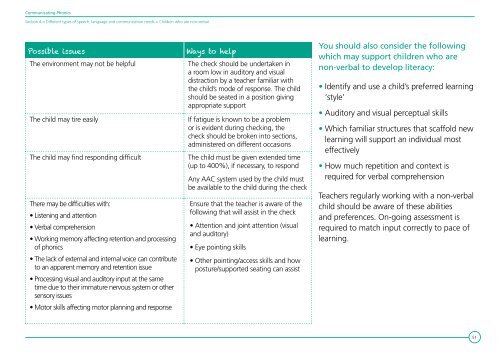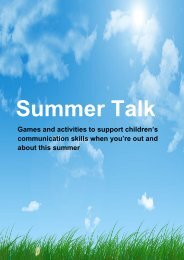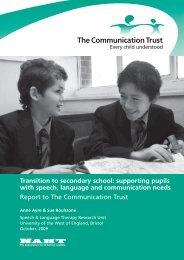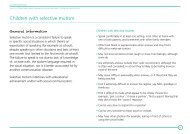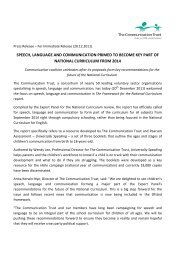Communicating Phonics - The Communication Trust
Communicating Phonics - The Communication Trust
Communicating Phonics - The Communication Trust
You also want an ePaper? Increase the reach of your titles
YUMPU automatically turns print PDFs into web optimized ePapers that Google loves.
<strong>Communicating</strong> <strong>Phonics</strong>Section 4 > Different types of speech, language and communication needs > Children who are non-verbalPossible issues<strong>The</strong> environment may not be helpful<strong>The</strong> child may tire easily<strong>The</strong> child may find responding difficult<strong>The</strong>re may be difficulties with:• Listening and attention• Verbal comprehension• Working memory affecting retention and processingof phonics• <strong>The</strong> lack of external and internal voice can contributeto an apparent memory and retention issue• Processing visual and auditory input at the sametime due to their immature nervous system or othersensory issues• Motor skills affecting motor planning and responseWays to help<strong>The</strong> check should be undertaken ina room low in auditory and visualdistraction by a teacher familiar withthe child’s mode of response. <strong>The</strong> childshould be seated in a position givingappropriate supportIf fatigue is known to be a problemor is evident during checking, thecheck should be broken into sections,administered on different occasions<strong>The</strong> child must be given extended time(up to 400%), if necessary, to respondAny AAC system used by the child mustbe available to the child during the checkEnsure that the teacher is aware of thefollowing that will assist in the check• Attention and joint attention (visualand auditory)• Eye pointing skills• Other pointing/access skills and howposture/supported seating can assistYou should also consider the followingwhich may support children who arenon-verbal to develop literacy:• Identify and use a child’s preferred learning‘style’• Auditory and visual perceptual skills• Which familiar structures that scaffold newlearning will support an individual mosteffectively• How much repetition and context isrequired for verbal comprehensionTeachers regularly working with a non-verbalchild should be aware of these abilitiesand preferences. On-going assessment isrequired to match input correctly to pace oflearning.51


